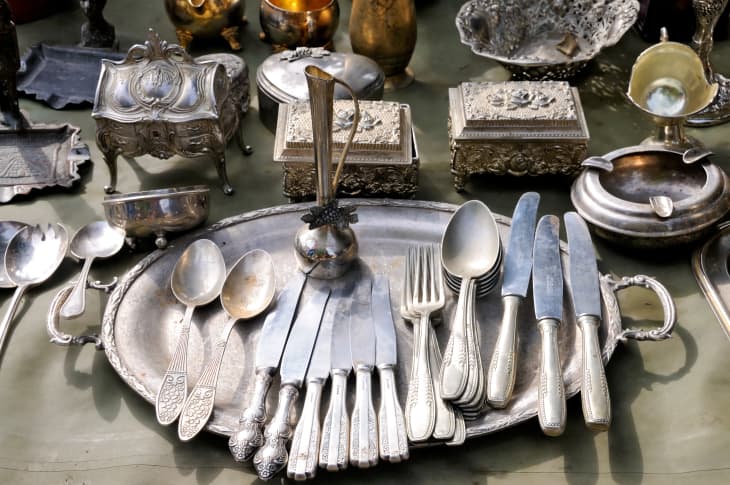Sorry, Parents: Nobody Wants the Family “Heirlooms”

In a modern world currently intrigued by minimalism, there’s something that all three adult generations can agree on: the problem of dealing with the collections curated (hoarded?) by our family members. From younger boomers and Gen X’ers sandwiched between their aging/dying parents and their own children to millennials trying to gently manage expectations (and their own limited budgets and storage space) without hurt feelings, the message is crystal clear. As Forbes said recently, “Sorry, nobody wants your stuff.”
When my mother sold our childhood home—a 2,600 square foot townhouse with a garage and basement, where my parents raised me and my two siblings in a suburb of Boston—the downsizing and packing process was nothing short of traumatizing. Probably at least half of our total square footage was allotted as storage. And we had become a family of pack rats who collected “family valuables.”
Like many of their generation, my mom and dad have always found it hard to throw anything away. Not just throw anything away, but give it away to charity or sell it to someone else who might truly treasure it; to them, everything has value, everything “might be needed again later”, everything might be something “you kids will want someday.” And when you’re part of a large, multi-generational Italian-American family with roots in the same city for hundreds of years, you start to collect not just your own things but all of the things from all of the relatives who’ve passed over the years. Because, you know, “antiques.”
This becomes an actual problem when you’re trying to whittle down the collection to the things that have value (sentimental or actual). During my mother’s move, for every box we packed up to donate, sell, or recycle, two boxes were unpacked to make sure there wasn’t anything that “must be kept.” By the time the movers showed up, we hadn’t even touched the basement or the garage.
If this sounds familiar, then welcome to the club of grown children who don’t want their parents’ (or grandparents’, or great-aunts-and-uncles’) stuff—and the older folks for whom this realization is “downright painful,” according to a report this summer by the Christian Science Monitor.
In the piece, the Monitor echoes:
As baby boomers begin to downsize, they are discovering their grown children do not want their stuff. In fact, they recoil in something close to horror at the thought of trying to find room for collections of Hummels and Thomas Kinkade paintings.
And it’s true, in my family as well as those featured by the Monitor: While my mom is a natural-born interior designer with a talented eye for textiles and a knack for collecting beautiful pieces from her world travels, and my father’s appreciation for literature, art, history, and the classics has shaped both my and my siblings’ intellectual curiosity, we want to start and curate our own collections—we want to be surrounded by pieces that are curated to reflect our travels, our memories, our ways of entertaining, and our personal styles.
Sure, that may include maybe a dozen or so family treasures and heirlooms with a history or a lesson or sentimental value—like the one leather-bound anthology of the Complete Works of Shakespeare that was my grandfather’s when he was a Harvard undergrad that now occupies a place of prominence in our living room, versus the hundred or so other anthologies my husband and I overpaid for in our own collegiate years and then donated to Goodwill when we moved from Boston to Texas in 2013, not without some real emotion. Even tears.
The real issue isn’t really the stuff — it’s all of the emotions around the circle of life.
But, like many younger to middle-aged Americans, we don’t want to have to pay movers by the box or rent storage units by the month just to be able to “pass on” the things hoarded and left behind by others. We’d rather tell their stories or show a picture of them without having to actually live with and deal with and pay for keeping All. That. Stuff.
And the burden is only likely to grow, says The Boston Globe. The number of Americans ages 65 and older is projected to more than double, from 46 million to over 98 million by 2060, according to a 2016 report by the Washington, D.C.-based nonprofit Population Reference Bureau.
As that wonderful piece in the Globe goes on to outline, the real crux of the issue isn’t actually the stuff, anyway—it’s all of the emotions around the circle of life. Older generations can understand why the younger ones don’t want their belongings, but that doesn’t make the transitions less stressful. Rather than hanging on tightly, however, experts suggest that they “try to reframe [the] situation, away from loss and toward joy,” by using that fine china for everyday breakfast, or the gold-rimmed crystal for iced tea.
“Who cares if the gold comes off? The kids don’t want it,” Anne Lucas, a professional organizer and founder of Ducks in a Row, told the Globe.
But if you can’t bear to see your cherished pieces diminished in quality through regular use, then sit down together with loved ones now and decide what to donate to charity thrift shops, what to sell to antiques dealers—who are finding a renewed renaissance online, according to a new report by 1stdibs.com —or just have a good, old-fashioned garage sale where you can talk through items and find them good, new, loving homes with other people who will treasure them and with whom you can meet and pass those memories on to face-to-face.
But please, don’t guilt your kids into keeping all (or any) of your stuff. Or they might just “forget” their copy of The Life-Changing Magic of Tidying Up next time they visit.